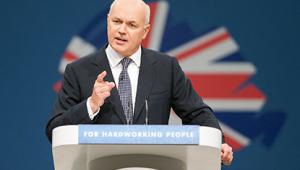By Richard Johnstone | 9 July 2012
Around 25% of the early participants in the government’s flagship back-to-work scheme were off benefits after 36 weeks, figures released by the Department for Work and Pensions have revealed today.
The first analysis of entrants into the Work Programme also found that around half – 48% – of the total 28,600 taking part had some break in their benefit claim during the period from last June to the end of March.This includes around 24% of the total cohort having a continuous break in claim of 13 weeks, and 14% having a continuous break of 26 weeks. Of those who left benefits most quickly (in the first 10 weeks), 7 out of 10 were still off benefits 13 weeks later.
The programme, which was launched in June last year, is the biggest back-to-work programme ever in Britain. Welfare-to-work firms across 18 areas provide tailored support to those at risk of long-term unemployment, and are then paid based on how many find work.Job outcome payments are made after 13 or 26 weeks in employment, with a further sum then paid for sustained employment after that.
Responding to the figures, employment minister Chris Grayling saidthe fact that almost one in four of participants who started in June had already completed at least three successive months off benefits was ‘a promising start in what’s been a very difficult labour market’.
He added that early indications show this figure will have continued to rise and could now – a year into the scheme – be as high as 30%.
‘People I meet in the industry already say that performance is well ahead of where it was at the same stage with the Flexible New Deal from which it took over, and this data gives further encouragement,’ Grayling said. ‘Now the welfare-to-work industry really has to demonstrate that it can reach new levels in helping the long-term unemployed back to work.’
Full data on jobs found is not yet available, and most claimants have to be in a job for six months before the providers receive an outcome payment. Official statistics will be published for the first time in the autumn.
The Employment Related Services Association, the trade association for the welfare-to-work industry, welcomed the figures as ‘a first step towards greater transparency’. It represents 98% of Work Programme prime contractors.
Chief executive Kirsty McHugh said: ‘Welfare-to-work providers want to be transparent about how they are performing and today’s release of figures is therefore welcomed as a first step to cutting through some of the misleading and inaccurate figures being bandied around in some quarters.
‘The truth is that the welfare-to-work industry is pulling out all the stops to help jobseekers into employment despite the challenging economic backdrop.’
Claimants of Jobseeker’s Allowance will remain on the Work Programme for two years, and it is expected to provide support to around 2.4 million people over the next five years.




















